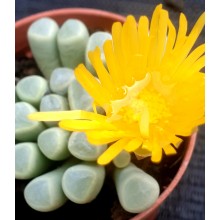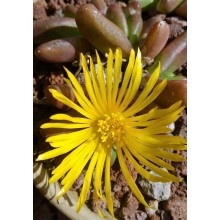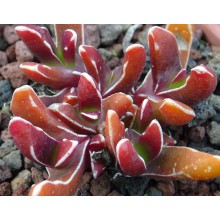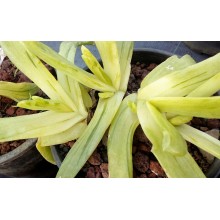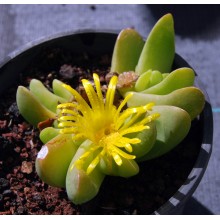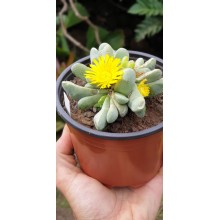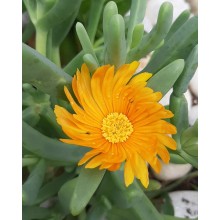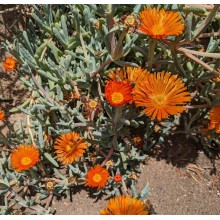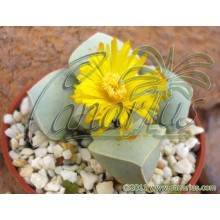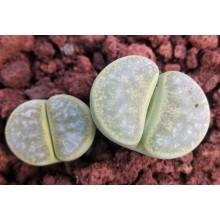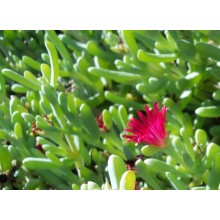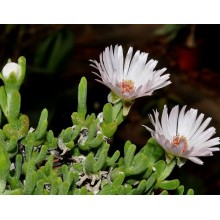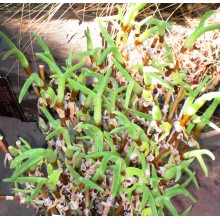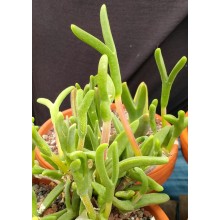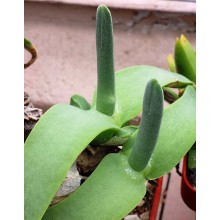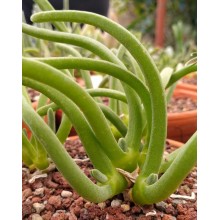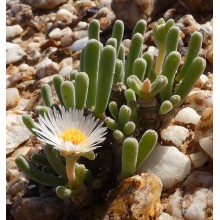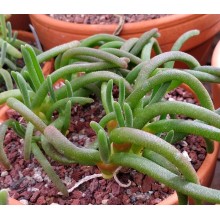Mesembs There are 56 products.

This group of desert plants is briefly named Mesembs because they belong to a botanical family formerly named Mesembryanthemaceae. There are almost 2.000 species, mainly found in Southern Africa, with extreme adaptations to dry habitats. Some are called "living stones", as they look like pebbles. Many are easy to grow and their main need is full sun. Some are difficult because they grow in truly extreme areas.
Our Web Shop offers sun grown healthy plants, with compact and colourful leaves. Some plants are sold as cuttings, and others as rooted plants, of at least two years old.
-
Fenestraria rhopalophylla ssp aurantiaca
Fenestraria rhopalophylla ssp aurantiaca
Cont. 6 cm. A beauty from South Africa. This succulent has unusual leaves with a translucent window on the top. Beautiful daisy like flowers. Easy to grow, needs a winter rest.
10,50 € -
Glottiphyllum pygmaeum
Glottiphyllum pygmaeum
This is the most compact species in the genus Glottyphyllum, and to many the most beautiful. Bake it in full sun and it will turn deep red when stressed.
11,70 € -
Glottiphyllum difforme
Glottiphyllum difforme
This is the most beautiful and least known species in the genus Glottiphyllum. Few collectors grow it and no pictures in the web show the beauty of well-grown plants.
16,80 € -
Glottiphyllum neilii
Glottiphyllum neilii
The "King of the Glotts" is said to be the largest of all the species in the genus Glottiphyllum. Leaves can get quite red when somehow stressed, It is easy to grow, and just as the rest of the genus Glottiphyllum it is chiefly winter-growing but it does not have a true resting season.
10,70 € -
Glottiphyllum oligocarpum
Glottiphyllum oligocarpum
This is a very attractive compact and blue glotty. Leaves are short and waxy and can look blue to grey. The flowers are so large that they cover the whole rosette.
12,00 € -
Jordaaniella cuprea
Jordaaniella cuprea
This virtually everblooming mesemb is an excellent ground cover, with glaucous leaves and showy, large, copper-coloured flowers. We offer two large sized cuttings.
10,80 € -
Jordaaniella dubia
Jordaaniella dubia
Succulent groundcover of South Africas coastal regions. Finger-like leaves appear year round with long stems that root as they go, it produces yellow flowers of about 6cm of diameter.
11,00 € -
Lapidaria margaretae
Lapidaria margaretae
Cont.= 6 cm. Beautiful living-stone plant from Namibia. Lapidaria is a classic of plant mimicry to rocks. Give filtered sun or light shade and water sparingly. It will take 25° F (-4 ° C) for short periods
10,70 € -
Lithops lesliei f. albinica C036A
Lithops lesliei f. albinica C036A
Lithops lesliei is a rather easy to grow living stone which is hypervariable as it occurs in a very wide area of South Africa. This form, albinica, is especially attractive because the whole plant turns golden yellow or bright green depending on the season.
10,30 € -
Malephora crocea
Malephora crocea
Three 20 cm cuttings. Grey leaved succulent ground cover, with remarkable orange-red glossy flowers. It thrives incoastal Mediterranean climates, especially on slopes. It can also bekept in a pot and trimmed back seasonally
10,80 € -
Mitrophyllum clivorum
Mitrophyllum clivorum
This large sized Mitrophyllum branches freely and produces erect slender stems. It starts branching early from base. Large plants can grow tall as small shrubs, reaching 60 cm in height. Mitrophyllum clivorum produces yellow flower.
18,50 € -
Mitrophyllum grande
Mitrophyllum grande
This large sized Mitrophyllum branches from the base and produces many flowers. It does not grow erect stems. The species of Mitrophyllum are winter growing South African mesembs and they produce two different pairs of leaves each year.
18,50 € -
Mitrophyllum mitratum
Mitrophyllum mitratum
This large sized Mitrophyllum branches freely and produces erect stems. Large plants can grow tall as small shrubs, reaching 50 cm in height.
21,00 € -
Monilaria moniliformis
Monilaria moniliformis
Monilaria are winter-growing succulent mesembs from the from the Western Cape of South Africa. In Monilaria moniliformis the internodes are often larger than long, 1-2 cm thick. It is recognizeable from the other species by the round, soft, short-collared sheaths which completely cover the leaves for the next growth period.
21,00 €
At the moment there are few products in this category Mesembs
















